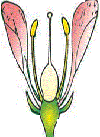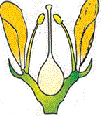Flower in plant
The flower is the reproductive unit in the angiosperms and it is meant for sexual reproduction.
A typical flower has four different kinds of whorls arranged successively on the swollen end of the stalk or pedicel, called thalamus or receptacle.
These are calyx, corolla, androecium and gynoecium. The calyx and corolla are accessory organs, while androecium and gynoecium are reproductive organs.
In some flowers like lily, the calyx and corolla are not distinct and are termed as perianth.
When a flower has both androecium and gynoecium, it is bisexual. A flower having either only stamens or only carpels is unisexual.
Based on symmetry, the flower may be actinomorphic (radial symmetry) or zygomorphic (bilateral symmetry).
When a flower can be divided into two equal radial halves in any radial plane passing through the centre, it is said to be actinomorphic, examples are mustard, datura, chilli.
When it can be divided into two similar halves only in one particular vertical plane, it is zygomorphic, examples are pea, gulmohur, bean, Cassia.
A flower is asymmetric (irregular) if it cannot be divided into two similar halves by any vertical plane passing through the centre, as in canna.
A flower may be trimerous, tetramerous or pentamerous when the floral appendages are in multiple of 3, 4 or 5, respectively.
The Flowers with bracts-reduced leaf found at the base of the pedicel- are called bracteate and those without bracts, ebracteate.
Based on the position of calyx, corolla and androecium in respect of the ovary on thalamus, the flowers are described as hypogynous, perigynous and epigynous.
| Hypogynous | Perigynous | Epigynous |
|
|
|
| In the hypogynous flower the gynoecium occupies the highest position while the other parts are situated below it. The ovary in such flowers is said to be superior, e.g., mustard, china rose and brinjal. | If gynoecium is situated in the centre and other parts of the flower are located on the rim of the thalamus almost at the same level, it is called perigynous. The ovary here is said to be half inferior, e.g., plum, rose, peach. | In epigynous flowers, the margin of thalamus grows upward enclosing the ovary completely and getting fused with it, the other parts of flower arise above the ovary. Hence, the ovary is said to be inferior as in flowers of guava and cucumber, and the ray florets of sunflower. |
The main part of a flower
Most of flowers have four main parts:
Petals,
Stamen (anther and filament),
Pistil (stigma, style and ovary) and
Sepals.
After flowers are pollinated and fertilized, they produce seeds in the ovary of the flower.

Pedicel
Pedicel is the stalk of the flower. Plants that have a stalk are known as pedicellate flowers and those do not have a stalk are known as sessile flowers.
Receptacle
Receptacle is the base of the flower and lies above the pedicel. In fact, Receptacle is a modified shoot that forms the floral axis and holds the layers of the flower.
Calyx
This layer is the first layer in the flower structure. They are said to be modified leaves. ‘Calyx’ is the word given for a collection of sepals. The sepals or calyx are often green in colour. It is to protect the flower starting from the bud stage.
Corolla
This forms the second whorl of the flower structure. ‘Corolla’ is the term for the collection of petals. The petals are the colourful parts of the flower to which the pollinators are attracted to. In many flowers, the Corolla is scented to further make the flower attractive. Like the sepals, the petals are also said to be modified leaves.
The petals are normally arranged in radial symmetry which means the flower can be divided into three equal parts. The androecium and gynoecium often follow the symmetry seen in the calyx and corolla. The calyx and corolla are collectively called the perianth.
The corolla may also be gamopetalous (petals united) or polypetalous (petals free). The shape and colour of corolla vary greatly in plants. Corolla may be tubular, bellshaped, funnel-shaped or wheel-shaped.
Aestivation: The mode of arrangement of sepals or petals in floral bud with respect to the other members of the same whorl is known as aestivation.
The aestivation are following type:
|
Valvate |
Twisted |
Imbricate |
Vexillary |
|---|---|---|---|
|
When sepals or petals in a whorl just touch one another at the margin, without overlapping, as in Calotropis, it is said to be valvate. |
If one margin of the appendage overlaps that of the next one and so on as in china rose, lady’s finger and cotton, it is called twisted. |
If the margins of sepals or petals overlap one another but not in any particular direction as in Cassia and gulmohur, the aestivation is called imbricate. |
In pea and bean flowers, there are five petals, the largest (standard) overlaps the two lateral petals (wings) which in turn overlap the two smallest anterior petals (keel), this type of aestivation is known as vexillary. |
|
|
|
|
Androecium
Androecium is composed of stamens. Each stamen which represents the male reproductive organ consists of a stalk or a filament and an anther.
Each anther is usually bilobed and each lobe has two chambers, the pollen-sacs. The pollen grains are produced in pollen-sacs. A sterile stamen is called staminode.
Stamens of flower may be united with other members such as petals or among themselves. When stamens are attached to the petals, they are epipetalous as in brinjal, or epiphyllous when attached to the perianth as in the flowers of lily.
The stamens in a flower may either remain free (polyandrous) or may be united in varying degrees.
The stamens may be united into one bunch or one bundle (monoadelphous) as in china rose, or two bundles (diadelphous) as in pea, or into more than two bundles (polyadelphous) as in citrus.
There may be a variation in the length of filaments within a flower, as in Salvia and mustard.
Stamen is made up of the following parts:
| Filament | Filament is a long slender tube like structure that holds the anther at the top of it. |
| Anther |
Anther is the pollen producing part of the plant. It is made up of four chambers or segments known as pollen sacs. The anthers give rise to microspores during their development and each of these microspores forms a pollen grain that carries the male gamete. The nucleus in the pollen grain divided mitotically to form two male nuclei. |
Gynoecium
Gynoecium forms the fourth whorl of the flower and is often found towards the centre of the flower. Gynoecium is the female reproductive part of a flower. The gynoecium is a term given to a collection of pistils or carpals. Gynoecium is made up of the following structures:
| Stigma | Stigma is the sticky end of the style which is responsible for catching pollen when they are pollinated. |
| Style | Style is a thin tube-like structure that holds the stigma and is attached to the ovary at its base. |
| Ovary | Ovary is the swollen basal portion of the flower which houses the ovules which contain the female gamete. On the Basis, position of the ovary with respect to the other flower whorls it can be classified into three types: |







